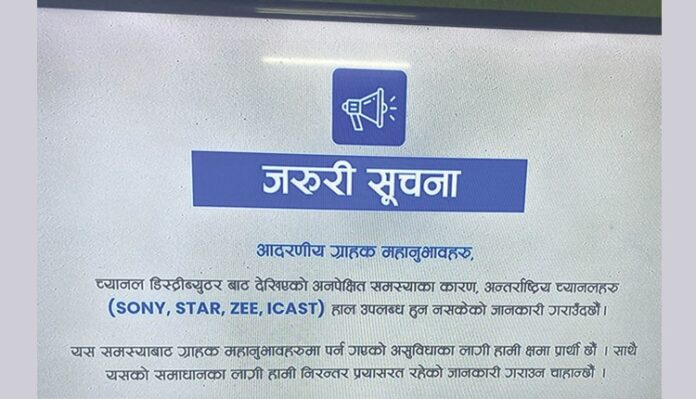If you’re a regular TV watcher, then you might have noticed that most of the Indian channels and sports channels are not available right now. In recent times, there has been a growing concern among Nepali viewers regarding the unavailability of Indian news channels in Nepal. Below in this article, we shall try to shed some light on why Indian Channels disappeared suddenly.
Table of Contents
Why Indian Channels Disappeared Suddenly:
The disruption in service stems from a dispute between Nepali channel distributors and Indian broadcasters. The Nepali distributors have reportedly failed to pay the Indian broadcasters for over a year and a half, accumulating dues that could amount to Rs 1 billion. In response, the Indian Broadcasting and Digital Foundation, representing TV broadcasters and digital platforms in India, cut off channel services to Nepal.
The Blame Game
The Ministry of Information and Communication Technology in Nepal has been blamed for not facilitating the necessary foreign exchange payments through the Nepal Rastra Bank. However, the ministry claims that the local distributors have not applied for the required foreign exchange facility, which is necessary to transfer funds to the Indian broadcasters.
Sudip Acharya, Managing Director of Dish Media Network, stated that his company had already paid the Nepali distributors after collecting payments from customers. Acharya expressed frustration, noting that they are now under pressure from customers demanding the return of their payments. Similarly, an official from WorldLink Communications, Nepal’s largest internet service provider, mentioned that the issue remains unresolved, even after the tenure of former communication minister Rekha Sharma.

Communication Breakdown
Despite repeated efforts by distributors like DMB Holdings, which handles the distribution of Star and Zee networks, there seems to be a lack of clear communication between the distributors and the ministry. Manish Singh, CEO of DMB Holdings, mentioned that they had submitted all necessary documents, including payment details, to the ministry in June 2024. Yet, no progress has been made, leaving distributors and customers in limbo.
NETTV, one of the major operators with 1.3 million customers, posted a message on its website acknowledging the issue but offered no clear timeline for when services would resume.
The A La Carte System and Its Complications
The ongoing payment dispute is also tied to the implementation of the à la carte system, which was formally introduced in Nepal in August 2023. This system allows viewers to select and pay only for the channels they want to watch, rather than subscribing to a full package of channels. While this system was intended to reduce costs for consumers, it appears to have added a layer of complexity to the payment process between distributors and broadcasters.
Gajendra Kumar Thakur, spokesperson for the communication ministry, stated that the ministry is ready to recommend payments to broadcasters as soon as the distributors apply. However, only a few distributors have shown interest in clearing their dues, exacerbating the issue.
The Impact on Consumers
Consumer rights activists have voiced strong concerns about the situation, labeling the advance collection of payments without delivering services as a violation of consumer rights. They argue that this practice amounts to cheating and is illegal.
The ministry has formed an informal committee to assess the exact amount owed by distributors to the broadcasters and to work towards resolving the issue. However, there is no clear indication of when the channels will be back on air, leaving millions of Nepali viewers frustrated and without the services they have paid for.
As the situation drags on, it remains to be seen how and when this dispute will be resolved, and whether the affected customers will receive any form of compensation for the interruption in service.
Also check out this article, for an extensive report on the issue.







